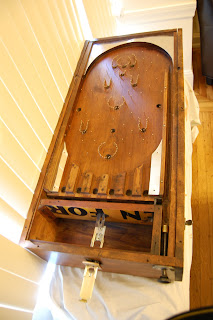One of my favorite things about living in California is being able to share a bit of my own childhood with Mimi. Coming from a family of collectors, if not hoarders, there's no shortage of vintage goodies tucked away just waiting to be rediscovered.
One of the most unique items from my boyhood days, and also one of my favorites, is the family's early pin-game - a precursor of modern pinballs.
About 3 feet long and a foot and a half wide, this machine really does show how pinball got its name. It is, quite simply, a board covered with pins. And through these pins drop a series of balls, scoring points by slotting into various holes along the way. It is both a terribly basic and terribly addictive little arcade game.
Our family never knew much of the history behind it. However, a neighbor of ours, originally from the east coast, once commented that he'd seen rows of them in Coney Island back in the early 30s. And they hadn't been just for amusement. Men would gather round a machine, place their bets down on the glass, and then pull back the plunger to see how they fared. We didn't do any betting at home, but we did thereafter refer to it as the Coney Island Pinball.
It sat in our home in Paradise, atop a coffee table in the living room, for as long as I remember. I think my father bought it after I was born, but well before I could remember him doing so. It was always a star attraction in our home, particularly for younger kids. I eventually outgrew it - transitioning to a full-size pinball - but whenever we had children under 10 over to the house, they'd go mad for it. It's simple enough for a 2 year old to understand, but requires enough finesse to keep a man of 34 (or so I'm told) intrigued game after game. As such, I really wanted to bring it home for Mimi and for her cousins. With this machine, amazingly, we can have a shared childhood experience, despite more than a 30 year gap.
It wasn't just a matter of bringing the machine out of storage and setting it on a table, though. 30 years ago my father had gone through the machine, gently oiling the wood and polishing up the brass. It had been beautiful when I was 4, but the past 30 years had not been kind. When it came back to me several weeks ago, it was a bit worse for wear. The glass top had been shattered, the brass pins and trim were corroded, the play-field covered in years of grime, and the mechanisms, simple as they are, virtually frozen with grit and neglect. I had my work cut out for me.
It was so filthy, Mimi ran away from it!
I began by removing all of the brass, including the pins, and cleaning/oiling the wood with some wood restorer and steel wool. This brightened up the play-field immediately.
Now, given that I had started this process around 8pm, most persons would have stopped to continue the next day. But I get impatient. It's one of my primary flaws when it comes to completing long-term projects. I don't have the patience. I'll keep on a project, gunning for the finishing point, deep into the night, quickly stretching beyond my limits of stamina and skill. This is why, a few weeks ago, Sumie found me at 2am hunched over the play-field, high as a kite on brass cleaner, mumbling to myself and I reinserted some 200 brass nails. I decided (read: was forced) to stop there.
One can see just how much cleaning had been needed. Here's the coin mechanism, half of it cleaned, half yet to be polished.
The next day I finished with all the trim and tweaked the brass nails into more concentric shapes. It was starting to look good.
The final piece was to purchase glass for the machine. Originally it would have come with wooden rails that went over the glass to keep cheaters out and the coin box safe, but these had long been lost. I did, however, get safety glass for the machine, double-thick, and this has had a tremendous impact on the feel of the machine. The play went from being grainy, harsh, and intolerably loud to smooth, muffled, and relaxing.
Also, Mimi could now play along with me and not grab the steel balls and fling them across the room. I appreciated this. Here she is pulling back the plunger and then watching the steel balls come down, all to shouts of "Bah-ru!!!"
Since restoring the machine I've done a bit of research on it. As you may have noticed, it's not a "factory" piece. The rail separating the play-field from the coin mechanism has been made from an old sign that seemed to say "now open" on one side and "open for.." on the other at one point.
This, I think, makes this machine a rather unique piece. It is definitely based on the "Whiffle Board," which is typically credited as the first pinball (http://www.ipdb.org/machine.cgi?gid=3552). Chances are that my machine is a beautifully hand-made knock-off, of which there were many in the early 30s. The original Whiffle Board was a bit of a sensation. However, through my research I've found that there were 10 prototypes of the original Whiffle Board (none documented photographically, as far as I know) put into operation before the inventors settled on a final play-field. There's a chance, albeit a small one, that this is one of those original prototypes. Well, I suppose Mimi and I will have another activity to share in the near future. A visit to the Antiques Roadshow.













No comments:
Post a Comment